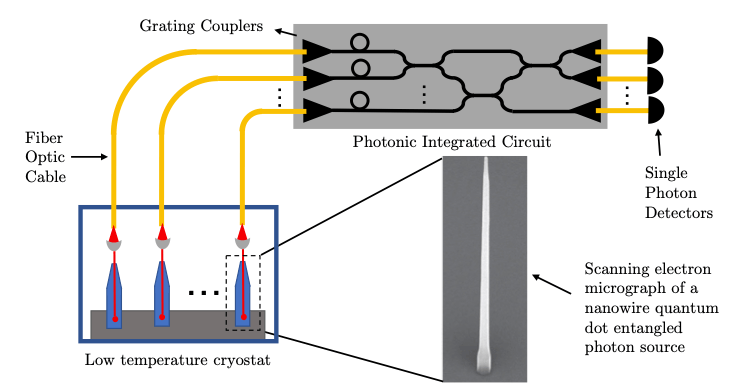Photonic quantum processors based on integrated quantum photonic circuits require entangled photon pairs to perform quantum computations. However, current state-of-the-art technologies utilize probabilistic entangled photon sources with limited pair-extraction efficiencies, negatively affecting the computation speed. This project aims to boost the speed of on-chip quantum operations by using bright, on-demand entangled photon sources with an extraction efficiency of more than two orders of magnitude higher than the existing state-of-the-art technology based on probabilistic photon sources. Our novel photon source will be developed by embedding quantum dots in tapered nanowire waveguides and surrounding them with a microcavity that accommodates entangled photons. This setup will produce bright, highly entangled photon pairs at a specified rate in a well-defined time interval, with high single-photon purity, pair extraction efficiency, photon indistinguishability, and entanglement fidelity. The tapered geometry of the nanowire allows for simple and efficient coupling of the produced photons into a low-loss optical fibre. This will enable the quantum dot sources to operate in a low-temperature cryostat, while the integrated photonic circuits operate at room temperature. Through fibre optic cables, the photons will be inserted into the integrated photonic circuit using custom-designed components such as grating couplers and edge couplers. This modular approach will be used to implement a vital protocol known as entanglement swapping, which is critical for large-scale quantum computing. Two core operations, a Bell-state measurement and quantum state tomography, will be performed by the integrated photonic circuits. The result of the procedure will be that two remote integrated photonic circuits will share entanglement. This novel quantum light source technology combined with integrated quantum photonic circuits will boost the speed, efficiency, and scalability of quantum operations compared to the current state-of-the-art system. Thus, this project will develop critical components of quantum photonic technologies that can pave the way for more secure communication, increase computation speed for complex problems, and enable a large-scale photonic quantum processor to be built in Canada.

Figure 1. Illustration of the proposed experimental system for interfacing entangled photons emitted by the nanowire quantum dot sources with photonic integrated circuits for implementing quantum computing tasks on-chip. The emission from multiple entangled photon sources based on nanowire quantum dots that sit at low temperatures will be coupled to single-mode fibres. Using grating couplers, the entangled photons will be coupled into the photonic circuit for processing and then coupled out for detection.
Related Content

Quantum Sensing with Small Quantum Systems
Summary There are small quantum systems over which we have very good control and which have long lifetimes. Examples include the phosphorous (P) defect in silicon (Si) and the nitrogen vacancy (NV) defect in diamond. With P defect in Si, we focus on improving our understanding of the hyperpolarization mechanism to better enable engineering of […]
December 1, 2016
Fabrication of Ultra Low Noise RF SQUID Amplifiers
A superconducting quantum interference device (SQUID) is an extremely sensitive magnetic field detector.
June 1, 2017

Metasurfaces for high-efficiency parametric downconversion and complex quantum state generation
Summary Entangled photon sources are crucial for quantum computing, quantum sensing, and quantum communication. Of growing importance are sources relying on spontaneous parametric downconversion (SPDC). Unfortunately, these sources of entangled photons are often constrained by momentum conservation laws. To overcome this limitation and expand the possibility of quantum state engineering, we intend to use metasurfaces […]
February 1, 2023

Quantum Simulations of Fundamental Interactions
Summary To address questions in modern physics such as “what is the structure of matter inside neutron stars?” we need better computational methods to evaluate the interplay of fundamental forces between elementary particles. To-date the response to such questions rests on numerical computer simulations that are inherently limited. In this project, we develop new theoretical […]
April 18, 2019

